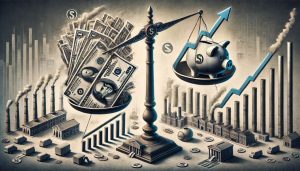The Impact of Counterfeit Currency Circulation on the National Economy

By : Dr. Abdul Wadud Nafis, LC., M.E.I.
Imagine a society where the money you hold no longer provides a sense of security. When you hand over a banknote to purchase basic necessities, there’s a lingering doubt: Is it genuine? Will it be accepted? The circulation of counterfeit currency is not merely a petty crime; it is a significant threat that can shake the foundations of a nation’s economy.
Counterfeit currency is more than fraud—it erodes trust, exacerbates inflation, and even casts a shadow of instability in the eyes of the international community. Its impact is felt not only by individuals or businesses but also by monetary policies that underpin macroeconomic stability.
The question is, how well do we understand the destructive effects of this phenomenon? Let us delve deeper into why counterfeit currency circulation is a “time bomb” for the macroeconomy that we cannot afford to ignore.
Below is an analysis of the macroeconomic impact of counterfeit currency circulation, presented with detailed narratives:
1. Erosion of Trust in the Financial System
The circulation of counterfeit currency can lead to a loss of trust in the financial system. When counterfeit currency is widespread, people begin to doubt the authenticity of the money they hold, including that received from official financial institutions. This distrust can affect financial stability, especially if people start converting their savings into assets like gold or foreign currencies, which can weaken demand for the local currency.
2. Rising Inflation
Counterfeit money increases the money supply without corresponding growth in the value of goods and services in the market. This can lead to price increases or inflation. Inflation caused by counterfeit currency is destructive because it does not support real economic growth but merely diminishes purchasing power.
3. Hampered Economic Growth
The presence of counterfeit currency creates uncertainty in economic transactions. Consumers and businesses become more cautious in their transactions, eventually slowing economic activity. Additionally, businesses may incur extra costs to detect counterfeit money, reducing their operational efficiency. This uncertainty also discourages investment as investors tend to avoid unstable markets.
4. Disruption of Monetary Policy
Central banks rely on accurate data about the money supply to formulate monetary policy. Counterfeit currency circulation skews this data, complicating decision-making processes such as interest rate adjustments or inflation control. Consequently, the effectiveness of monetary policy in maintaining price stability and promoting economic growth can be compromised.
5. Decline in State Revenue
Counterfeit currency circulation can reduce formal economic activity as individuals and businesses feel insecure in transactions. As a result, potential tax revenue decreases. Furthermore, if counterfeit currency circulation occurs on a large scale, it can affect the national currency’s exchange rate in international markets, negatively impacting the economy.
6. Losses for Individuals and Companies
Individuals or companies that accept counterfeit money suffer direct losses as such money cannot be used for transactions. These losses can diminish individuals’ purchasing power and harm company finances, especially if the counterfeit money received is significant.
7. Increased Oversight Costs
Governments and financial institutions must allocate substantial funds to combat counterfeit currency circulation. Measures such as enhancing currency printing technology, tightening oversight, and educating the public require significant budgets. These costs are an additional burden that could otherwise be allocated to more productive sectors.
Conclusion
Counterfeit currency circulation poses a serious threat to the macroeconomy, from undermining public trust and causing inflation to hindering economic growth and complicating monetary policy. Addressing this issue requires strong collaboration between the government, financial institutions, and society to combat counterfeit currency and raise awareness of its dangers.
Counterfeit currency is a silent threat capable of disrupting macroeconomic stability. It erodes trust, triggers inflation, and hampers economic growth while complicating monetary policy. Its impact is not only felt by individuals but also by the nation as a whole. Combating counterfeit money is not merely the government’s responsibility but a shared obligation to maintain economic balance and ensure a more stable future.
References
1. Bank Indonesia. (2020). “Currency Security and Counterfeit Prevention.” Jakarta: Bank Indonesia.
2. Mankiw, N. G. (2019). “Principles of Economics” (8th Edition). Boston: Cengage Learning.
3. Mishkin, F. S. (2021). “The Economics of Money, Banking, and Financial Markets” (13th Edition). New York: Pearson Education.
4. Krugman, P., & Wells, R. (2020). “Macroeconomics” (6th Edition). New York: Worth Publishers.
5. Yusuf, M. (2018). “The Impact of Counterfeit Currency Circulation on Economic Stability.” Journal of Economics and Public Policy, 7(3), 45-57.
6. World Bank. (2021). “Financial Integrity and the Fight Against Counterfeit Currency.” Washington, DC: World Bank Publications.
7. Otoritas Jasa Keuangan. (2021). “National Financial Inclusion Strategy and Counterfeit Prevention.” Jakarta: OJK.

